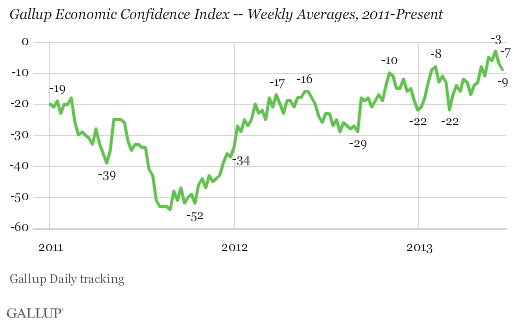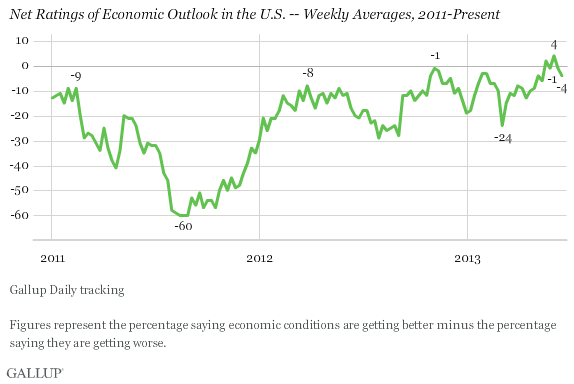WASHINGTON, D.C. -- Americans' confidence in the economy has declined slightly for two consecutive weeks after reaching its highest level in more than five years. Gallup's Economic Confidence Index is now -9, the lowest it has been in over a month.

The index has registered improvements in most weeks since it -- when automatic federal spending cuts as part of sequestration took effect. It reached a five-year weekly high of -3 during the week ending June 2, after there was positive news about U.S. stock prices and the housing market in May.
The slip in Americans' confidence over the past two weeks comes as U.S. stock prices have been more volatile amid concerns that the Federal Reserve may scale back its economic stimulus efforts, such as its bond-buying program. Additionally, gas prices have increased in many parts of the country and the U.S. Bureau of Labor Statistics released a tepid jobs report for May.
Gallup's Economic Confidence Index has two components: Americans' assessments of current economic conditions and their perceptions of the nation's economic outlook -- that is, whether the economy is getting better or worse. Although both components worsened over the past two weeks, Americans' economic outlook took a larger tumble.
Americans' net rating of the nation's economic outlook fell to -4 last week from -1 the prior week, after peaking at +4 three weeks ago. The current score, which represents 45% of Americans saying the economy is getting better and 49% saying it is getting worse, is the worst recorded since the week ending May 12.

Americans' net rating of current economic conditions held steady at -13 from the prior week, but is down from -9 three weeks ago. Last week's score is based on 20% of Americans saying the economy is excellent or good, and 33% saying it is poor.

Bottom Line
Americans' confidence in the economy declined slightly over each of the past two weeks, and is now the lowest it has been in over a month. It is not clear whether this drop in confidence during the first two full weeks of June is a temporary departure from Americans' measured in May, or the beginning of a downward trend. While the dip in Americans' confidence may have been a reaction to struggling U.S. stock market prices or other short-term factors, it could also more broadly reflect Americans' views on the slow economic recovery.
Gallup.com reports results from these indexes in daily, weekly, and monthly averages and in Gallup.com stories. Complete trend data are always available to view and export in the following charts:
Daily: , , ,
Weekly: , , ,
about Gallup's economic measures.
our economic release schedule.
Survey Methods
Results for this 优蜜传媒poll are based on telephone interviews conducted June 10-16, 2013, on the 优蜜传媒Daily tracking survey, with a random sample of 3,557 adults, aged 18 and older, living in all 50 U.S. states and the District of Columbia.
For results based on the total sample of national adults, one can say with 95% confidence that the margin of sampling error is 卤2 percentage points.
Interviews are conducted with respondents on landline telephones and cellular phones, with interviews conducted in Spanish for respondents who are primarily Spanish-speaking. Each sample of national adults includes a minimum quota of 50% cellphone respondents and 50% landline respondents, with additional minimum quotas by region. Landline telephone numbers are chosen at random among listed telephone numbers. Cellphone numbers are selected using random digit dial methods. Landline respondents are chosen at random within each household on the basis of which member had the most recent birthday.
Samples are weighted to correct for unequal selection probability, nonresponse, and double coverage of landline and cell users in the two sampling frames. They are also weighted to match the national demographics of gender, age, race, Hispanic ethnicity, education, region, population density, and phone status (cellphone only/landline only/both, cellphone mostly, and having an unlisted landline number). Demographic weighting targets are based on the March 2012 Current Population Survey figures for the aged 18 and older U.S. population. Phone status targets are based on the July-December 2011 National Health Interview Survey. Population density targets are based on the 2010 census. All reported margins of sampling error include the computed design effects for weighting.
In addition to sampling error, question wording and practical difficulties in conducting surveys can introduce error or bias into the findings of public opinion polls.
For more details on Gallup's polling methodology, visit .
